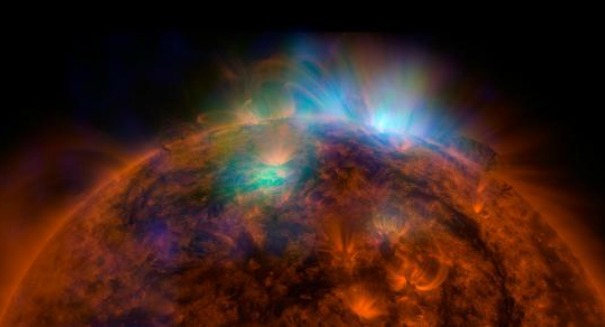
Scientists are hopeful that NuSTAR can answer key questions about the sun, including why the sun's corona is so much hotter than its surface.
Using complex mirror optics, a NASA spacecraft has taken one of the most spectacular images of the surface of the sun that scientists have yet seen.
NASA’s Nuclear Spectroscopic Telescope Array (NuSTAR) was designed to look at black holes tremendous distances away, but scientists decided to have it take a peak into its own backyard, using its images of high-energy X-rays and overlaying it on a picture of the sun to create the image, according to the Christian Science Monitor.
Calling it the most sensitive solar portrait ever taken, NASA said photos like this will help researchers learn more about the sun, providing a unique look at the star in a much deeper way than before.
NuSTAR’s observations can be seen in blue and green. They are overlaid on an image of the sun taken by NASA’s Solar Dynamics Observatory spacecraft.
NuSTAR was launched back in June 2012 and was intended to study distant black holes which give off X-ray light, but solar scientists wanted to have it look at our sun first. NuSTAR is perfectly tailored to view the high-energy X-rays that the sun emits.
Scientists are hopeful that NuSTAR can answer key questions about the sun, including why the sun’s corona — outer atmosphere — is a whopping 1.8 million degrees Fahrenheit when the surface is just 10,800 degrees.
Researchers think “nanoflares” might be to blame for the much higher coronal temperatures, and NuSTAR could help put the question to bed for good — or at least provide more clues, as nanoflares give off X-rays. They hope the spacecraft will continue to provide high-quality images in the coming years.
The spacecraft could also tell researchers more about the nature of dark matter, which scientists believe makes up 85 percent of matter in the known universe. Dark matter doesn’t emit or absorb light, making it only observable through seeing its effects on the gravitational field. However, X-ray light may allow for more direct observations of such matter.
Leave a Reply